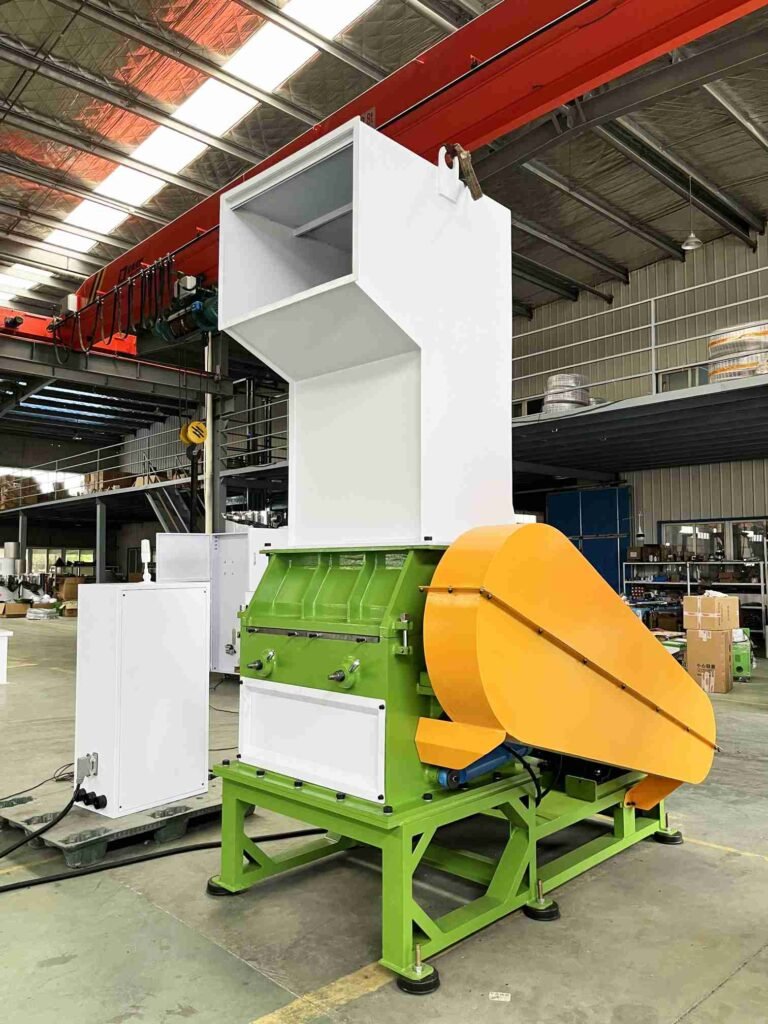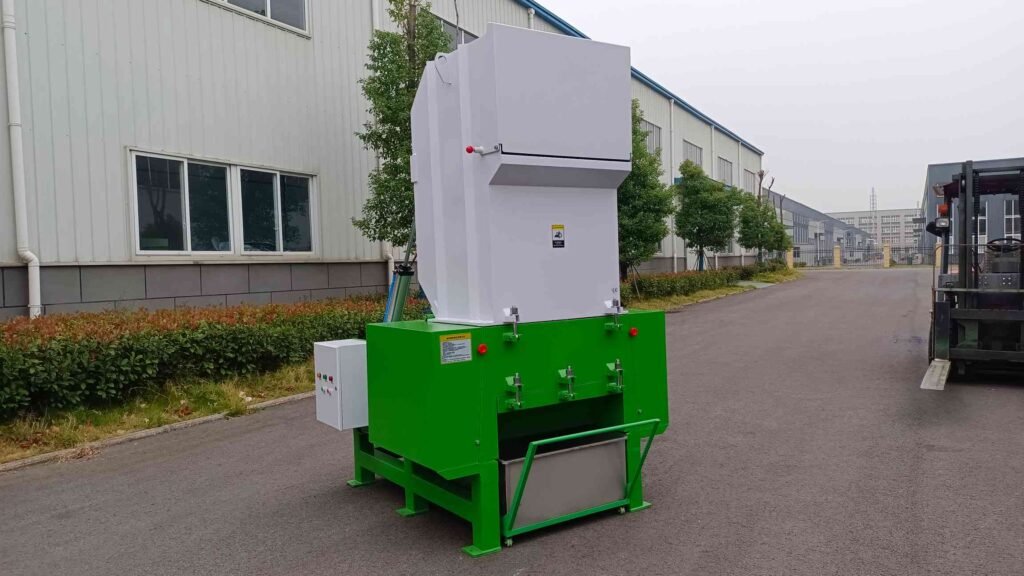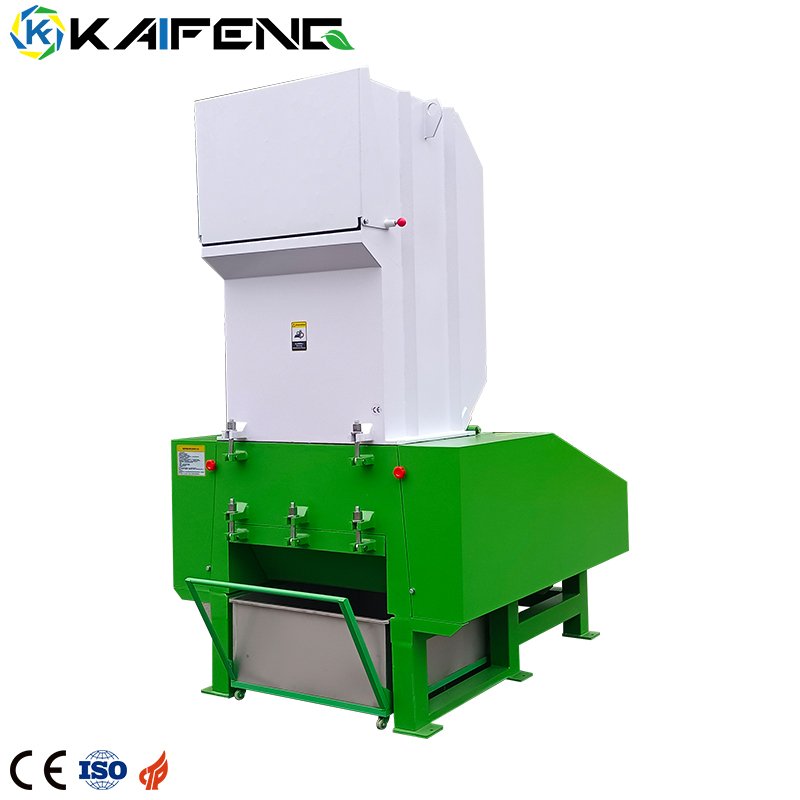Da eine nachhaltige Gesundheitsfürsorge immer mehr an Bedeutung gewinnt, ist eine effiziente Bewirtschaftung der zunehmenden medizinischen Kunststoffabfälle zu einer Notwendigkeit geworden. Die Integration eines Hochleistungs-Kunststoffzerkleinerer mit Zusatzausrüstungen in Form von industriellen Kastentrocknern, Kunststoffmaschinen, Kunststoffformmaschinen, wassergekühlten Kältemaschinen, luftgekühlten Kältemaschinen und Pulverladern verändert die Abfallbehandlungsverfahren. Im Folgenden werden diese neuen Anwendungen detailliert beschrieben und es wird aufgezeigt, wie diese Technologien zusammenwirken, um das Management medizinischer Abfälle voranzutreiben.

I. Einleitung
Medizinische Abfälle bestehen aus verschiedenen Arten von Einwegkunststoffen, die täglich in Krankenhäusern anfallen. Missmanagement gefährdet die Gesundheit von Mensch und Umwelt. Die Wirksamkeit der Behandlung wird durch den Einsatz eines Kunststoffzerkleinerers erhöht, da er das Volumen der Abfälle reduziert und eine einfachere Weiterverarbeitung ermöglicht.
1. Die Rolle der Kunststoffzerkleinerungsmaschine bei medizinischen Abfällen
Der Kunststoffzerkleinerer zerkleinert große Mengen medizinischer Kunststoffabfälle in handliche Größen, um Sterilisation, Transport und Recycling zu erleichtern. Seine Verwendung erleichtert die Entsorgung und den Umgang mit infektiösen Materialien.
2. Die Bedeutung von Hilfsmitteln
Hilfsmaschinen wie Industriekistentrockner und Kunststoffmaschinen erleichtern das Recycling von geschreddertem Kunststoff zu wiederverwertbaren Rohstoffen. Kühlsysteme wie luft- und wassergekühlte Kältemaschinen sorgen für eine hohe Effizienz der Anlagen und verhindern eine Überhitzung bei längerem Betrieb und gewährleisten einen reibungslosen Produktionsprozess.
3. Ökologische und betriebliche Vorteile
Die Kombination dieser Technologien verringert das Kontaminationsrisiko, reduziert die Behandlungskosten und fördert eine umweltfreundliche Gesundheitsversorgung. Die synergetische Strategie hilft Krankenhäusern bei der Einhaltung von Vorschriften und fördert allgemeine Nachhaltigkeitsprogramme.

II. Art und Typ der medizinischen Kunststoffabfälle
Die Beschaffenheit der medizinischen Kunststoffabfälle muss bekannt sein, damit geeignete Behandlungstechnologien entwickelt werden können. Medizinische Kunststoffabfälle bestehen hauptsächlich aus Einwegartikeln, die mit Krankheitserregern kontaminiert sind. Ihr vielfältiges Material erfordert spezielle Behandlungs- und Recyclingverfahren. Volumenreduzierung mit einem Kunststoffzerkleinerer Maschine ist so zu gestalten, dass eine wirksame Bewirtschaftung die einfache Umwandlung von gefährlichen Abfällen in wiederverwendbare, wiederverwertbare Materialien ermöglicht.
1. Arten von medizinischen Kunststoffabfällen
Zu den allgemeinen Abfällen gehören Einwegspritzen, Infusionsschläuche, Verpackungsmaterial, Einweghandschuhe und Schutzkittel. Diese Materialien, die gelegentlich kontaminiert sind, müssen entsorgt werden, um Infektionsrisiken zu vermeiden.
2. Infektionsrisiken und Art der Materialien
Das Risiko einer Kontamination mit hochbiologischen Agenzien wie Viren und Bakterien macht eine sichere Handhabung sehr wichtig. Außerdem bestehen die Kunststoffe selbst aus anderen Polymeren wie PVC, PE und PP mit unterschiedlichen mechanischen und chemischen Eigenschaften, die sich auf die Recyclingfähigkeit auswirken.
3. Herausforderungen in Bezug auf Volumen und Handhabung
Medizinische Kunststoffe sind zwar leicht, nehmen aber viel Platz ein und machen die Lager- und Transportlogistik kompliziert. Sie müssen in einem Kunststoffzerkleinerer zerkleinert werden, um den Platzbedarf zu maximieren und eine einfachere und sicherere Abfallbehandlung zu ermöglichen.
III. Regeln und Vorschriften für die Entsorgung medizinischer Abfälle
Medizinische Abfälle unterliegen strengen Vorschriften zur Förderung der Sicherheit und zum Schutz der Umwelt. Das medizinische Personal muss sowohl nationale als auch internationale Gesetze einhalten, die die Trennung, sichere Verbringung und Entsorgung vorschreiben. Ausrüstung wie Kunststoffzerkleinerer und Kunststoffverarbeitungsmaschinen müssen für die Einhaltung von Sicherheits- und Umweltstandards zertifiziert sein.
1. Regulatorische Anforderungen
Medizinische Abfälle müssen gemäß den gesetzlichen Vorschriften behandelt werden, die in der Regel die Trennung von Abfällen, die Eindämmung und die Behandlung von Abfällen vorschreiben, um das Risiko von Gesundheitsschäden zu verringern.
2. Normen für die Ausrüstung
Behandlung von Abfällen mit zugelassenen Geräten wie Zerkleinerer für medizinische Kunststoffe und Kunststoffspritzgießmaschinen gewährleistet, dass die Abfallbehandlung den Sicherheits- und Umweltstandards zum Schutz der Arbeitnehmer und der Gesellschaft entspricht.
3. Rückverfolgbarkeit
Die Rückverfolgbarkeit und detaillierte Aufzeichnungen während der Entsorgung sorgen für Verantwortlichkeit und erleichtern die Prüfung, so dass die Institutionen die Vorschriften einhalten und die Transparenz der Prozesse maximieren können.
IV. Technischer Aufbau und Merkmale von speziell angefertigten medizinischen Kunststoffzerkleinerern MASCHINE
Die technische Ausführung der Zerkleinerungsmaschine für medizinische Kunststoffe ist ausschlaggebend für ihre Sicherheit und Effizienz bei der Abfallbehandlung.
1. Effizienter Brecher-Mechanismus
Die Hochleistungs-Doppelwellen-Schleifmaschine mit legierten Messern zerkleinert harte, verschmutzte Kunststoffe in medizinischer Qualität schnell und effektiv auf eine einheitliche Größe für die Verarbeitung.

2. Sicherheits- und Hygienemerkmale
Abgedeckte Zuführungsöffnungen verringern die Exposition gegenüber gefährlichen Produkten, und automatische Staubabsaugsysteme sorgen für eine saubere Arbeitsumgebung und reduzieren die Luftverschmutzung.
3. Effizienter Betrieb des Kunststoffzerkleinerers
Eingebaute Kühlmittel in leistungsstarke Kunststoffzerkleinerungsmaschine verhindern eine Überhitzung bei Langzeitbetrieb. Die zerkleinerten Kunststoffe werden durch automatische Pulverlader der nächsten Behandlungsstufe zugeführt, was Arbeit spart und die Produktivität des Arbeitsablaufs erhöht.
V. Zerkleinerungsstufe in der Krankenhausabfallwirtschaft
Die Zerkleinerung ist eine sehr wichtige Phase, in der die Abfälle in Formen gebracht werden, die für die weitere Verarbeitung oder das Recycling geeignet sind.
1. Vorsortierung vor dem Zerkleinern
Eine effektive Vorsortierung entfernt nicht-plastisches Material, das den Brecher beschädigen oder die Rezyklate verunreinigen könnte, und ermöglicht so einen problemlosen Betrieb und qualitativ hochwertige Ergebnisse.
2. Trocknung von zerkleinerten Kunststoffen
Der industrielle Kastentrockner entzieht dem geschredderten Kunststoff Feuchtigkeit, um mikrobielles Wachstum zu verhindern und die Materialstabilität für das Recycling zu verbessern.
3. Recycling mit Formanlagen
Verarbeitete Kunststoffe werden von Kunststoffmaschinen und Kunststoffspritzgießmaschinen zu wiederverwendbaren Produkten wie medizinischen Schalen oder Behältern verarbeitet und ermöglichen so Ressourceneffizienz.
VI. Wie technologische Innovation eine verbesserte Abfallwirtschaft fördert
Technologie fördert die Sicherheit, senkt die Kosten und optimiert die Nachhaltigkeit. Kunststoffzerkleinerer der nächsten Generation sind mit intelligenten Sensoren zur Überwachung des Messerverschleißes und der Betriebstemperaturen ausgestattet, die eine vorausschauende Wartung und verbesserte Sicherheit ermöglichen. Die Integration des Zerkleinerungsprozesses, der Trocknung, des automatischen Materialtransports mit Hilfe von Pulverladern und der Kühlung mit wasser- oder luftgekühlten Kältemaschinen maximiert die Prozesse und reduziert die Arbeitskosten.
1. Klügere Operationen
Echtzeitüberwachung und -automatisierung erhöhen die Zuverlässigkeit und Sicherheit der Anlagen und verringern Ausfallzeiten und Wartungskosten.
2. Niedrigere Behandlungskosten
Integrierte Systeme für die innerbetriebliche Zerkleinerung, Trocknung und den Materialtransport reduzieren manuelle Handhabung, Transport- und Energiekosten und verbessern so die Gesamteffizienz des Betriebs.
3. Grüne Krankenhäuser ermöglichen
Durch die Umwandlung von Abfällen in wiederverwendbare Materialien und die Verringerung des ökologischen Fußabdrucks ermöglichen diese Arten von technischen Lösungen den Krankenhäusern, Nachhaltigkeitsziele und gesetzliche Normen zu erfüllen.
VII. Schlussfolgerung
Neue Anwendungen des Kunststoffzerkleinerers und der Zusatzgeräte wie Industriekastentrockner, Kunststofflader, Pulverlader, wassergekühlte Kühler, luftgekühlte Kühler und Kunststoffformmaschinen verändern die Entsorgung medizinischer Abfälle. Sie verbessern die Sicherheit, Effizienz und Nachhaltigkeit in Gesundheitseinrichtungen und ermöglichen einen verantwortungsvollen Umgang mit der Umwelt und eine umweltfreundliche Gesundheitspraxis.
